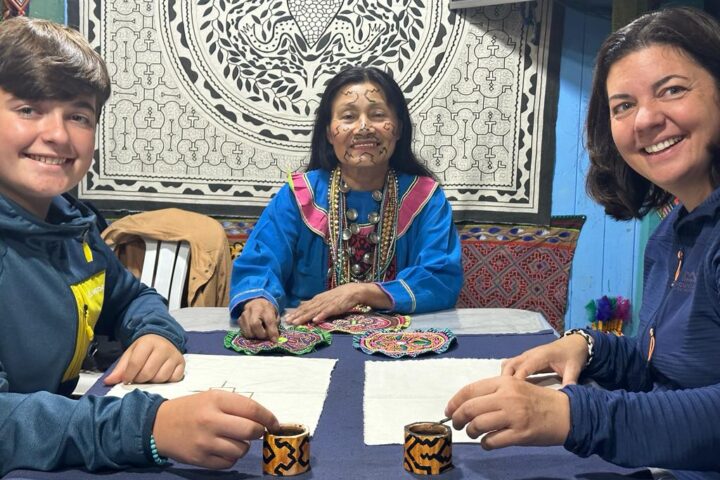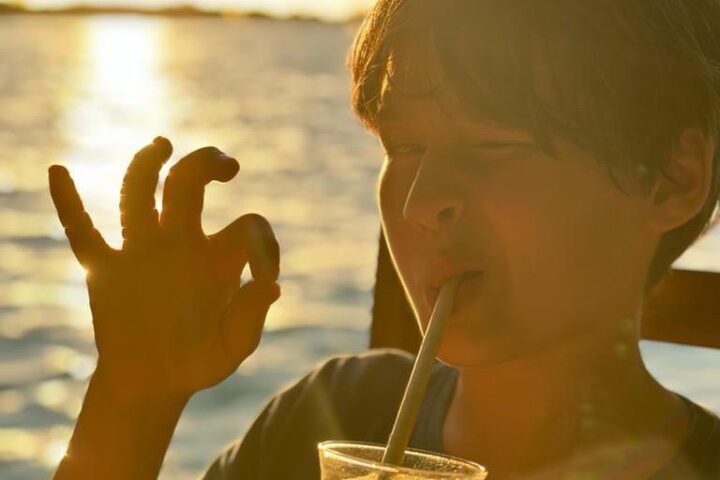At Aracari, we are big believers in the transformative power of travel, especially the kind that spans several months. So, when our friend Mirjam Peternek-McCartney – owner and founder of Lemongrass Marketing – consulted us for advice and guidance as she began planning a family sabbatical to South America, we were eager to help. Imparting our knowledge, contacts, and expertise, along with that of our trusted in-country partners – we have helped Mirjam in building the trip of a lifetime, as she spends from September to March ‘24 in our fascinating region with her family.
A year in the making, this extraordinary journey has just begun as Mirjam, her husband, and her two sons touched down in Cartagena, Colombia. Found on the crystal-clear shores of the Caribbean, Cartagena has long been one of our favorite cities on the continent, and it proved the perfect first chapter in this South American adventure. Now, two weeks in, the Peternek-McCartneys are headed to Peru, where they’ll begin in Lima, connecting with many of our friends in the coastal capital, before continuing to the Sacred Valley, spending six weeks staying at a traditional villa – the ideal base from which to explore wonders like Machu Picchu, Cusco, and the Amazon. After that and into November, the family sabbatical will cross to Bolivia, onto Chile, and into Argentina in the new year.
With Aracari’s knowledge helping Mirjam to plot the route of her journey, we’ve very generously been granted access to follow their story, sharing their personal insights and experiences with our readers. Because alongside the inevitable spark of wanderlust, we believe documenting Mirjam’s trip will also reveal the secrets of a sabbatical – becoming a testament to how to transform the dream of a family long family travel into a reality.
From their initial idea, the family has reshaped life’s logistics to fit their adventurous plans, covering everything from remote schooling to the practicalities of leaving home. And to mark the start of this sabbatical story, Mirjam has shared with us all the preparation that’s gone into it, along with her tips and a glimpse into what the family is most excited about in the months that lie ahead.
The Background: Where did the idea begin?
“My husband and I have traveled extensively before, having both lived and worked in different countries,” Mirjam explained. “We have had previous experience with sabbaticals too: In 2007 we spent six months traveling through China and then lived for another six on the Amalfi Coast – all whilst working. In 1996 I lived and worked in India and my husband spent a year in Sicily.”
“When we had our first son 14 years ago, we always said that if we can we’d like to travel again as a family. So, the idea of a family sabbatical has always been in the back of our minds. However, it was the pandemic that made us realize that time goes quickly and if we don’t do it now, we’ll never do it. Our eldest son will start his GCSEs next year so it was now or never. The pandemic also made us realize that you worry about all kinds of things – and then something you never imagine (like a pandemic) comes along and you are totally unprepared for it. Truly, it made us realize that you’ve only got one life and you need to make the most of it.”
“We chose South America because Peru had been on both of our bucket lists for a long time. Also, South America was a continent that neither of us had traveled to previously. We know Asia well, so we thought it would be great to explore a new continent together as a family.”
“We took the decision last summer whilst on holiday in Italy and told the kids pretty quickly (almost so that we couldn’t go back on our word ourselves!!). Our biggest worry was how the school would react to it. Luckily for us, they were very open to the idea. The school’s motto is “Live Adventurously” – so we argued that we are only really following the school’s ethos! Having said that there are now a ton of really useful books available on family sabbaticals, world schooling, etc. and you soon realize there’s a whole microcosm out there of families who blog, and share tips – amongst others on how to convince your school and workplace that this is a good idea.”
The Logistics: School, work, and a sabbatical?
Understandably, one of the biggest barriers to spending months away from home is the impact that can have on the routine of life. So how do Mirjam and her family plan to navigate that? “With regards to the school, we decided together with the teachers that for maths and science they would have an online tutor (which we organized ourselves – there are lots out there). Then for all other subjects, we would teach ourselves.”
“The school was great – we are loosely covering the curriculum, but adapting it to the locality we are in. So instead of “Welsh textiles” in Art, we would look at indigenous weaving techniques in Peru. One of the subjects in GCSE history is “Empires”, so instead of the British Empire, we’ll explore ideas around the Spanish Empire, the conquistadores, the impact on the indigenous peoples of South America, the slave trade (we have just left Cartagena, which is like a live history book on the above subjects!). So, we’ll simply adapt the curriculum to make it more relevant where we are in our journey. Tuesdays and Wednesdays are “official” school days, and those are the days when they have their tutors. However, each day they’ll have a project whether it’s journalling, learning Spanish on Duolingo, drawing a piece of art or a building, or something else we’ve seen on the road.”
“This also means that my husband will be working on Tuesdays and Wednesdays. In terms of work my husband will work remotely 2 days a week (he’s self-employed so thankfully rather flexible) and I run my own business and will regularly check in with the Team. I think again the pandemic has really helped, remote working is so much easier and much more accepted now. Also, the WiFi coverage is great across South America. In Colombia where we are now it’s better than in England! Every café has Wi-Fi, even in remote spots like the Rosario Islands where we are now.
“Something that other WorldSchoolers have recommended is not to “travel” constantly but to stay in one place for a while. So, we’ll be in the Sacred Valley in Peru for six weeks for example. This allows us to get into a routine, explore the place at a slow pace, and do lots of day trips/multi-day trips from there (to the Amazon for example, Inca Trail, etc.). They also recommended not to be totally prescriptive with school days – so if it rains…. use that day to get a lot of work or schoolwork under your belt. Apparently, 2 hours of world schooling equates to a full day of school in terms of what kids actually learn! So, we’ll see how that goes and will share our top tips and what we’ve learned at the end of the sabbatical.”
The Preparation: Organizing for months abroad.
Of course, it’s not just the trip itself that requires planning. “There was also quite a bit of logistical stuff to organize – like renting out our house, taking the cars off the road, getting all the vaccinations, international driving permits, getting insurance,” Mirjam told us.
“So yes, it does take time to organize it all, but you can include the kids in it as well! They swotted up on packing lists and the best ways to pack a backpack. We are traveling very light (1 large rucksack, 1 small daypack each) and the kids loved giving us advice on what to pack and what not to pack. Compression cubes are a lifesaver! They also did a lot of research on the best water filter bottles (Larq), washbags (Sea to Summit), foldable coffee mugs, and how to dress in layers.”
The Excited Anticipation: What lies ahead?
With months’ worth of adventures ahead, what excites the family most of what’s in store? “There are so many things! Learning about the Incas and immersing ourselves in this ancient culture; learning Spanish, Tambopata Research Center in the Amazon and learning more about the incredible biodiversity in this part of the world, exploring the coffee culture of Colombia, learning to Tango in Buenos Aires (me, not my husband – I love him but he’s a terrible dancer and we’ll be divorced otherwise by the end of the trip!), Patagonia, having an asado in Argentina…..I could go on!!”
But perhaps the most precious part? “Having time to spend together without rushing. Time for long chats – I think discovering a new continent together will bring us even closer together as a family.”
The Travel Part: Making a Sabbatical Sustainable
Alongside our travel tips and contacts, we’ve also been able to be a sustainability soundboard for Mirjam, who has her own motivations for wanting to ensure this 7-month adventure has a positive impact on the places and people she’ll be visiting.
“The world is an amazing place and people will always want to travel and explore,” says Mirjam. “But we want to make sure there’s still a liveable planet to explore for our children. Human-induced climate change is already having a devastating effect on many of the communities we are hoping to visit, so we will try, where we can, to minimize our footprint. Hence, we have chosen to travel overland wherever possible.”
“Traveling slowly and more mindfully, spending money with local businesses, and women-led businesses is one way of making sure tourism has a positive effect on our host communities. Traveling slowly also means you have a much lower carbon footprint, get to see the real country, and have much deeper and more meaningful experiences. It’s not as quick, but much more rewarding.”
Digital Postcodes from the Peternek-McCartneys
So, the family adventure has begun. Over the next seven months, we’ll follow their slow journey across South America, sharing digital postcard every six weeks that provide our readers with an authentic glimpse into the secrets of a sabbatical.
You never know, it might just inspire a year-long adventure in you.











